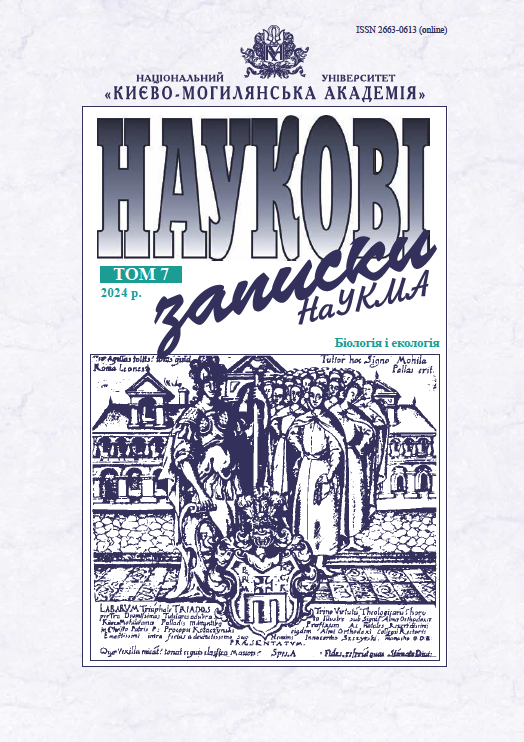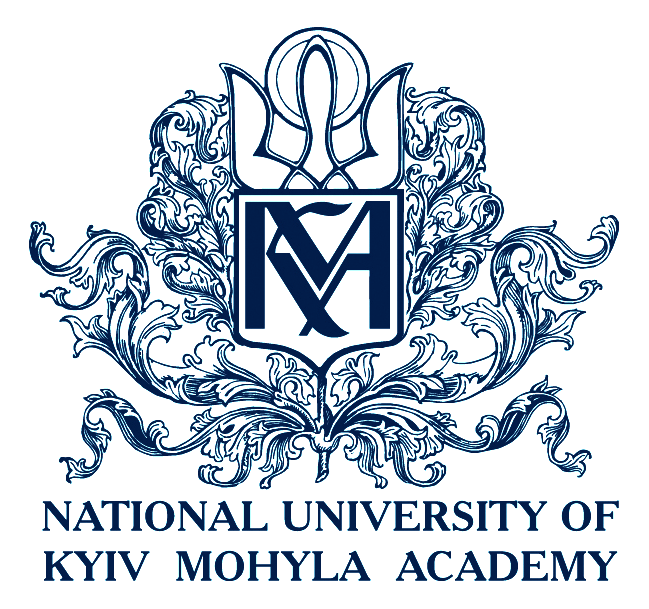Аналіз однонуклеотидних поліморфізмів у послідовностях генів Pina та Pinb диплоїдних пшениць Triticum monococcum і T. urartu
DOI:
https://doi.org/10.18523/2617-4529.2024.7.27-35Ключові слова:
пуроіндолін, Triticum monococcum ssp. aegilopoides, T. monococcum ssp. monococcum, T. urartu, SNP, радикальні амінокислотні заміни, консервативні амінокислотні заміниАнотація
Пуроіндоліни (пуроіндолін а і пуроіндолін b) – низькомолекулярні білки, що визначають текстуру ендосперму зерна видів триб Triticeae та Avenae. Метою цієї роботи був аналіз однонуклеотидних поліморфізмів (SNP) кодуючих послідовностей генів Pina та Pinb диплоїдних пшениць Triticum monococcum (AmAm) і T. urartu (AA) з бази даних NCBI порівняно з референсними послідовностями сорту пшениці м’якої Chinese Spring (CS).
З бази даних NCBI було відібрано 62 послідовності гена пуроіндоліну а T. monococcum (Pina-Am1), 22 послідовності Pina T. urartu (Pina-A1), 32 послідовності гена пуроіндоліну b T. monococcum (Pinb-Am1) і 13 послідовностей Pinb T. urartu (Pinb-A1). Як референсні послідовності використовували послідовності гена пуроіндоліну a (алель Pina-D1a) DQ363911.1 сорту CS та гена пуроіндоліну b (алель Pinb-D1a) DQ363913.1 CS з бази даних NCBI. Послідовності вирівнювали з використанням програми MEGA 11. Всього в загальній вибірці 84 послідовностей Pina диплоїдних пшениць ідентифіковано 34 SNP (13 синонімічних відмінностей, 21 несинонімічних, з яких 15 призводять до радикальних амінокислотних замін, 6 – до консервативних), частина з яких спостерігались у всіх послідовностях, а частина були поодинокими. Серед 45 послідовностей Pinb трапляється 36 SNP, але, на відміну від гена Pina, тут переважали синонімічні заміни (22); 7 замін призводили до радикальних амінокислотних замін та ще 7 – до консервативних. Заміни в послідовностях пуроіндолінових генів відносно генів CS можна розподілити на фіксовані в обох видів диплоїдних пшениць, ті, що фіксовані в T. urartu і за якими є поліморфізм у T. monococcum, та специфічні для кожного виду. Виявлено істотні відмінності в частотах трапляння альтернативних нуклеотидів у певних позиціях (81, 318, 322 і 384 Pina та 135 і 359 Pinb) у дикорослої пшениці T. monococcum ssp. aegilopoides і культивованої однозернянки T. monococcum ssp. monococcum.
Посилання
- Pauly A, Pareyt B, Fierens E, Delcour JA. Wheat (Triticum aestivum L. and T. turgidum L. ssp. durum) kernel hardness: I. Current view on the role of puroindolines and polar lipids. Comprehensive Reviews in Food Science and Food Safety. 2013;12(4):413-26. doi:10.1111/1541-4337.12019
- Shewry P. Wheat grain proteins: Past, present, and future. Cereal Chemistry. 2023;100(1):9-22. doi:10.1002/cche.10585
- Rai A, Han SS. Recent developments on the contribution of glutenin and puroindoline proteins to improve wheat grain quality. Cereal Chemistry. 2023;100(1). doi:10.1002/cche.10607
- Morris CF. Puroindolines: The molecular genetic basis of wheat grain hardness. Plant Molecular Biology. 2002;48(5-6):633-47. doi:10.1023/a:1014837431178
- Turnbull KM, Turner M, Mukai Y, Yamamoto M, Morell MK, Rahman S, et al. The organization of genes tightly linked to the Ha locus in Aegilops tauschii, the D-genome donor to wheat. Genome. 2003;46(2):330-338. doi:10.1139/g02-124
- Gautier MF, Aleman ME, Guirao A, Marion D, Joudrier P. Triticum aestivum puroindolines, two basic cystine-rich seed proteins: cDNA sequence analysis and developmental gene expression. Plant Mol Biol. 1994;25(1):43-57. doi:10.1007/BF00024197
- Morris CF. The antimicrobial properties of the puroindolines, a review. World Journal of Microbiology and Biotechnology. 2019;35(6):86. doi:10.1007/s11274-019-2655-4
- Elmorjani K, Geneix N, Dalgalarrondo M, Branlard G, Marion D. Wheat grain softness protein (Gsp1) is a puroindoline-like protein that displays a specific post-translational maturation and does not interact with lipids. Journal of Cereal Science. 2013;58(1):117-22. doi:10.1016/j.jcs.2013.03.012
- Morris CF, Geng H, Beecher BS, Ma D. A review of the occurrence of Grain softness protein-1 genes in wheat (Triticum aestivum L.). Plant Molecular Biology. 2013;83(6):507-521. doi:10.1007/s11103-013-0110-8
- Gautier MF, Cosson P, Guirao A, Alary R, Joudrier P. Puroindoline genes are highly conserved in diploid ancestor wheats and related species but absent in tetraploid Triticum species. Plant Science. 2000;153(1):81-91. doi:10.1016/S0168-9452(99)00258-7
- Chantret N, Salse J, Sabot F, Rahman S, Bellec A, Laubin B, et al. Molecular basis of evolutionary events that shaped the hardness locus in diploid and polyploid wheat species (Triticum and Aegilops). Plant Cell. 2005;17(4):1033-45. doi:10.1105/tpc.104.029181
- Tranquilli G, Lijavetzky D, Muzzi G, Dubcovsky J. Genetic and physical characterization of grain texture-related loci in diploid wheat. Molecular and General Genetics. 1999;262(4-5):846-50. doi:10.1007/s004380051149
- Li W, Huang L, Gill BS. Recurrent deletions of puroindoline genes at the grain hardness locus in four independent lineages of polyploid wheat. Plant Physiol. 2008 Jan;146(1):200-12. doi:10.1104/pp.107.108852
- Morris CF, Luna J, Caffe-Treml M. The Vromindolines of cv. Hayden oat (Avena sativa L.) – A review of the Poeae and Triticeae indolines and a suggested system for harmonization of nomenclature. Journal of Cereal Science. 2021;97:103135. doi:10.1016/j.jcs.2020.103135
- Charles M, Tang H, Belcram H, Paterson A, Gornicki P, Chalhoub B. Sixty million years in evolution of soft grain trait in grasses: Emergence of the softness locus in the common ancestor of pooideae and Ehrhartoideae, after their divergence from Panicoideae. Molecular Biology and Evolution. 2009;26(7):1651-61. doi:10.1093/molbev/msp076
- Wilkinson MD, King R, Grimaldi R. Sequence diversity and identification of novel puroindoline and grain softness protein alleles in Elymus, Agropyron and related species. Diversity. 2018;10(4):114. doi:10.3390/d10040114
- Feldman M, Levy AA. Triticum L. In: Wheat Evolution and Domestication. Springer, Cham; 2023. doi:10.1007/978-3-031-30175-9_10
- Taddei F, Gazza L, Conti S, Muccilli V, Foti S, Pogna NE. Starchbound 2S proteins and kernel texture in einkorn, Triticum monococcum ssp monococcum. Theoretical and Applied Genetics. 2009;119(7):1205-12. doi:10.1007/s00122-009-1121-3
- Kulathunga J, Reuhs BL, Zwinger S, Simsek S. Comparative study on kernel quality and chemical composition of ancient and modern wheat species: Einkorn, emmer, spelt and hard red spring wheat. Foods. 2021;10(4):761. doi:10.3390/foods10040761
- Michikawa A, Okada M, Ikeda TM, Nagaki K, Yoshida K, Takumi S. Phenotypic effects of Am genomes in nascent synthetic hexaploids derived from interspecific crosses between durum and wild einkorn wheat. PLoS ONE. 2023;18(4): e0284408. doi:10.1371/journal.pone.0284408
- Massa AN, Morris CF. Molecular evolution of the puroindoline-a, puroindoline-b, and grain softness protein-1 genes in the tribe Triticeae. J Mol Evol. 2006;63(4):526-536. doi:10.1007/s00239-005-0292-z
- Chen Q, Qi PF, Wei YM, Wang JR, Zheng YL. Molecular characterization of the pina gene in einkorn wheat. Biochem Genet. 2009;47(5-6):384-96. doi:10.1007/s10528-009-9239-1
- Guzmán C, Caballero L, Martín MA, Alvarez JB. Molecular characterization and diversity of the Pina and Pinb genes in cultivated and wild diploid wheat. Mol Breeding. 2012;30:69-78. doi:10.1007/s11032-011-9599-1
- Tamura K, Stecher G, Kumar S. MEGA11: Molecular Evolutionary Genetics Analysis version 11. Molecular Biology and Evolution 2021;38:3022-27. doi:10.1093/molbev/msab120
- Zhang J. Rates of conservative and radical nonsynonymous nucleotide substitutions in mammalian nuclear genes. Journal of Molecular Evolution. 2000;50(1):56-68. doi:10.1007/s002399910007
- Kim KH, Feiz L, Martin JM, Giroux MJ. Puroindolines are associated with decreased polar lipid breakdown during wheat seed development. Journal of Cereal Science. 2012;56(2):142-46. doi:10.1016/j.jcs.2012.02.011
- Lesage VS, Bouchet B, Rhazi L, Elmorjani K, Branlard G, Marion D. New insight into puroindoline function inferred from their subcellullar localization in developing hard and soft nearisogenic endosperm and their relationship with polymer size of storage proteins. Journal of Cereal Science. 2011;53:231-38. doi:10.1016/j.jcs.2011.01.002
- Quayson ET, Marti A, Morris CF, Marengo M, Bonomi F, Seetharaman K, et al. Structural consequences of the interaction of puroindolines with gluten proteins. Food Chemistry. 2018;253:255-61. doi:10.1016/j.foodchem.2018.01.146
- Geneix N, Dalgalarrondo M, Tassy C, Nadaud I, Barret P, Bakan B, et al. Relationships between puroindoline A-prolamin interactions and wheat grain hardness. PLoS ONE. 2020;15(9):e0225293. doi:10.1371/journal.pone.0225293
##submission.downloads##
Опубліковано
Як цитувати
Номер
Розділ
Ліцензія
Авторське право (c) 2024 O. Sozinova, Ya. Blume

Ця робота ліцензується відповідно до Creative Commons Attribution 4.0 International License.
Автори, які публікуються у цьому журналі, погоджуються з такими умовами:
а) Автори зберігають за собою авторські права на твір на умовах ліцензії CC BY 4.0 Creative Commons Attribution International License, котра дозволяє іншим особам вільно поширювати (копіювати і розповсюджувати матеріал у будь-якому вигляді чи форматі) та змінювати (міксувати, трансформувати, і брати матеріал за основу для будь-яких цілей, навіть комерційних) опублікований твір на умовах зазначення авторства.
б) Журнал дозволяє автору (авторам) зберігати авторські права без обмежень.
в) Автори мають право укладати самостійні додаткові угоди щодо поширення твору (наприклад, розміщувати роботу в електронному репозитарії), за умови збереження посилання на його першу публікацію. (Див. Політика Самоархівування)
г) Політика журналу дозволяє розміщення авторами в мережі Інтернет (наприклад, у репозитаріях) тексту статті, як до подання його до редакції, так і під час його редакційного опрацювання, оскільки це сприяє виникненню продуктивної наукової дискусії та позитивно позначається на оперативності та динаміці цитування опублікованої роботи (див. The Effect of Open Access).



